Keeping a high-fiber diet is key for good health. Fiber is mainly in fruits, veggies, whole grains, and legumes. It helps with digestion, lowers cholesterol, and keeps blood sugar and weight in check. Adults need 25-30 grams of fiber a day, but most get only 15.
This article will give you tips to boost your fiber intake. You’ll learn how to enjoy more health benefits.
Key Takeaways : High Fiber Diet
- A high-fiber diet is essential for maintaining overall health and well-being.
- Dietary fiber provides numerous benefits, including normalizing bowel movements, maintaining bowel health, lowering cholesterol levels, controlling blood sugar levels, and aiding in weight management.
- The recommended daily fiber intake for adults is 25-30 grams, but many Americans fall short, consuming only about 15 grams per day.
- This article will provide practical tips and strategies to increase your daily fiber intake and enjoy the associated health advantages.
- Incorporating more high-fiber foods into your diet can have a positive impact on your overall health.
What is Dietary Fiber?
Dietary fiber is the part of plant-based foods we can’t digest. It’s key for a healthy gut. Our bodies can’t fully break down fiber, but it’s good for us. It’s split into soluble and insoluble types, each with special benefits.
Soluble Fiber
Soluble fiber mixes with water to form a gel. This gel can lower blood cholesterol and sugar levels. You can find soluble fiber in oats, peas, beans, apples, citrus fruits, carrots, and psyllium.
Insoluble Fiber
Insoluble fiber helps move food through the digestive system and makes stool bulkier. This can help with constipation or irregular bowel movements. Great sources include whole-wheat flour, wheat bran, nuts, beans, and some veggies.
Eating a mix of high-fiber foods is best. They give you lots of nutrients and both soluble and insoluble fiber.
“Fiber is an essential component of a healthy diet, supporting digestive health and overall well-being.”
Benefits of a High Fiber Diet
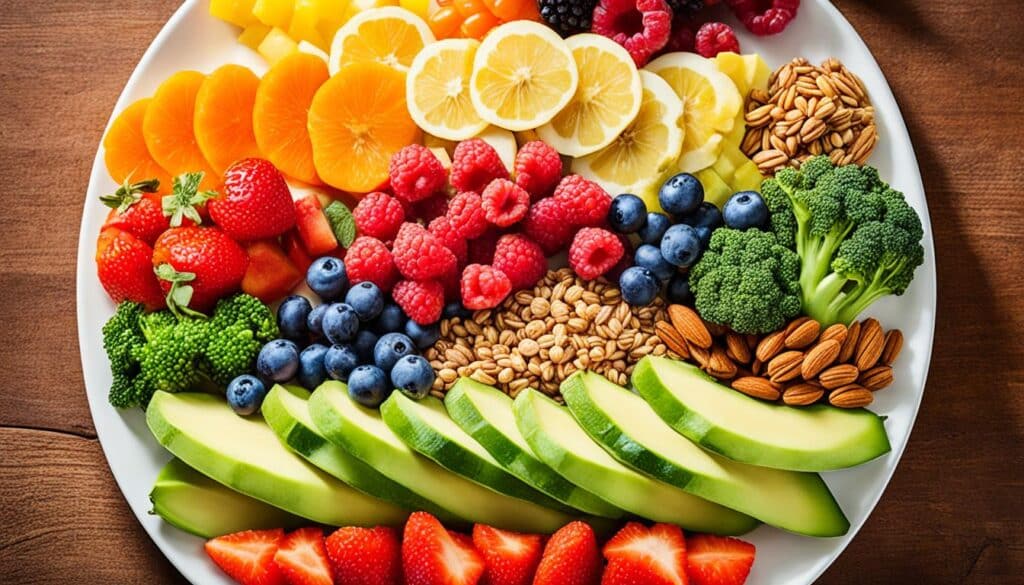
Eating a high-fiber diet can bring many health benefits. It helps with improved digestion, reduced cholesterol, and better blood sugar control. This diet can greatly improve your health.
A high-fiber diet makes your bowel movements regular and keeps your bowels healthy. It helps control the digestive process. This lowers the risk of getting hemorrhoids and diverticular disease.
Soluble fiber can also lower total blood cholesterol levels. It does this by reducing low-density lipoprotein (LDL), or “bad” cholesterol. This is good for your heart and lowers the risk of heart disease.
High-fiber foods are great for blood sugar control, especially for people with diabetes. The fiber slows down sugar absorption. This helps keep blood glucose levels stable.
Also, high-fiber foods can help with weight management. They make you feel full, so you eat less. Studies show that eating more dietary fiber, especially from cereal sources, can lower the risk of heart disease and some cancers. This means you could live a longer, healthier life.
| Health Benefit | Impact of High-Fiber Diet |
|---|---|
| Improved Digestion | Normalizes bowel movements, reduces risk of hemorrhoids and diverticular disease |
| Reduced Cholesterol | Lowers total blood cholesterol levels by reducing LDL (“bad”) cholesterol |
| Blood Sugar Control | Helps slow the absorption of sugars, leading to more stable blood glucose levels |
| Weight Management | Promotes a sense of fullness, reducing calorie intake |
| Longevity | Reduces risk of dying from cardiovascular disease and certain cancers |
Adding a high-fiber diet to your life brings many health benefits. These can make you feel better and help you live longer and healthier.
Recommended Daily Fiber Intake
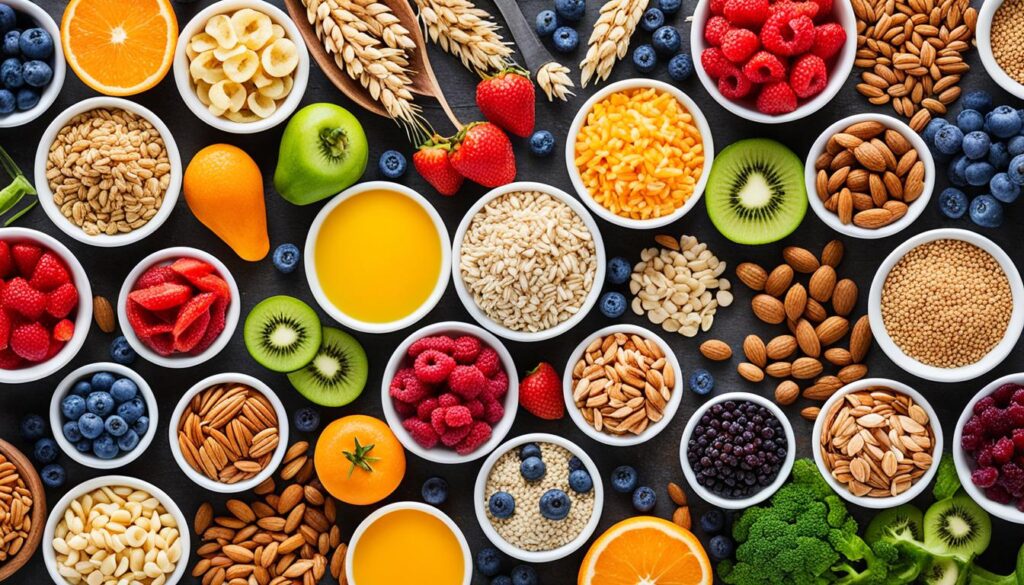
Getting the right amount of dietary fiber is key for good health. The Institute of Medicine gives comprehensive fiber intake guidelines for adults in the U.S. These guidelines help people know their fiber needs by age and gender.
The daily fiber recommendations are clear:
- Women aged 19-50: 25 grams of fiber per day
- Women aged 51 and older: 21 grams of fiber per day
- Men aged 19-50: 38 grams of fiber per day
- Men aged 51 and older: 30 grams of fiber per day
These fiber intake guidelines aim for the best health and disease prevention. Eating foods high in fiber brings many benefits. These include better digestion and a lower risk of chronic diseases.
| Age Group | Recommended Daily Fiber Intake |
|---|---|
| Women 19-50 years | 25 grams |
| Women 51 years and older | 21 grams |
| Men 19-50 years | 38 grams |
| Men 51 years and older | 30 grams |
Knowing these fiber intake guidelines helps you eat foods high in fiber. This way, you meet your individual fiber needs. And you enjoy the health perks of a fiber-rich diet.
High Fiber Food Sources
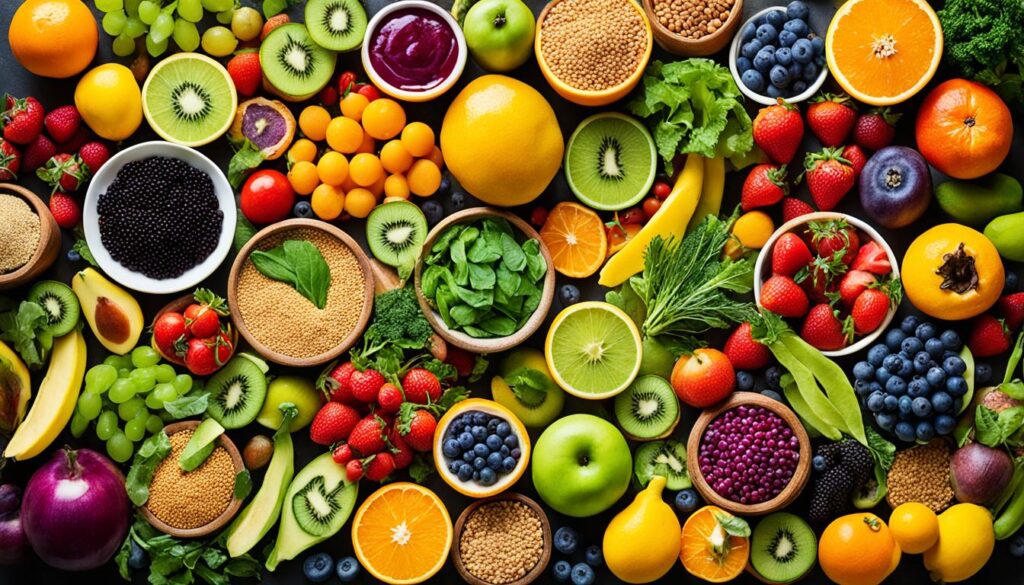
Adding high-fiber foods to your meals is key for getting enough fiber. These foods are packed with nutrients and can be found in many food groups. Each type offers special health perks.
Whole Grains
Whole-grain products like whole-wheat bread, brown rice, and oats are great for fiber. They keep their bran and germ, giving you more nutrients and dietary fiber.
Fruits and Vegetables
Fruits high in fiber like apples, pears, and berries are good choices. So are vegetables high in fiber like peas, broccoli, and artichokes. These foods are full of vitamins, minerals, and antioxidants, plus lots of fiber.
Legumes and Beans
Legumes and beans like lentils, chickpeas, and black beans are super fiber-rich. They give you up to 8 grams of fiber per serving. Adding these to your meals can really help you get more fiber.
Nuts and Seeds
Nuts and seeds like almonds and chia seeds are full of fiber. They’re great for snacks or adding to dishes for more dietary fiber.
By eating a mix of high-fiber foods, you can meet your fiber intake goals. This way, you get all the health benefits of a fiber-rich diet.
Tips for Adding More Fiber to Your Diet

Boosting your fiber intake is easy with a few simple changes. By making smart swaps and adding fiber-rich foods to your meals, you can increase your fiber levels. Here are some easy tips to help you do just that:
- Start your day with a high-fiber breakfast cereal or add a few tablespoons of unprocessed wheat bran to your favorite cereal.
- Choose whole-grain options over refined varieties whenever possible, such as switching to whole-wheat bread or brown rice.
- Experiment with baking using whole-grain flours or adding crushed bran cereal, unprocessed wheat bran, or uncooked oatmeal to muffins, cakes, and cookies.
- Incorporate more legumes, such as beans, peas, and lentils, into your meals for a fiber-rich boost.
- Snack on fresh fruits, raw vegetables, and whole-grain crackers. Dried fruits and nuts are also high-fiber, nutrient-dense options.
By making gradual changes and adding a variety of fiber-rich foods to your diet, you can easily increase your daily increasing fiber intake. This will help you enjoy the many benefits of a high-fiber diet.
Remember, practical tips to add more fiber don’t have to be hard. Start with small, easy changes. Soon, you’ll be making high-fiber food swaps and incorporating fiber into meals without effort.
High Fiber Diet
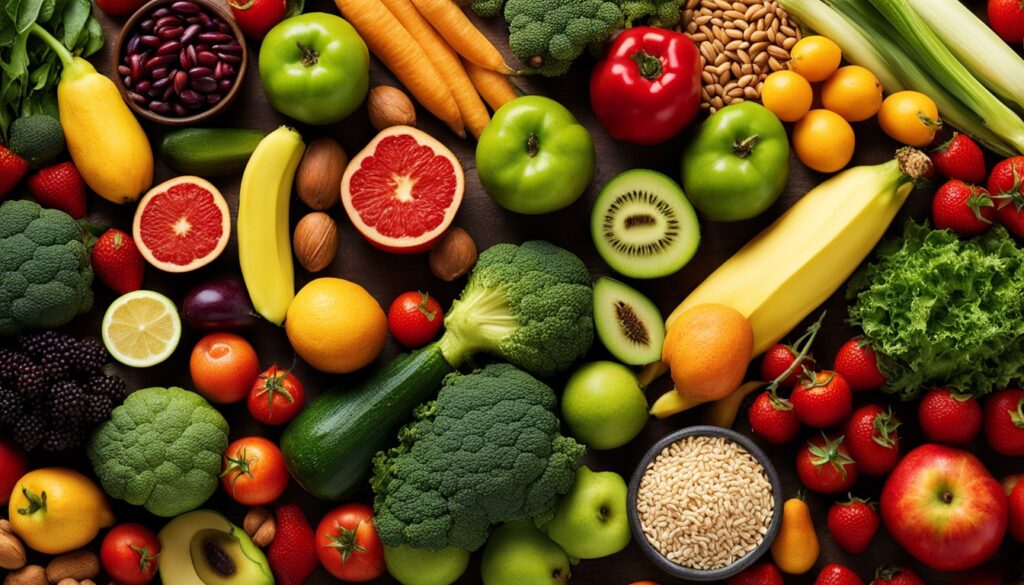
Eating a high-fiber diet is key for good health. Foods like whole grains, fruits, veggies, legumes, and nuts are full of fiber. They offer many benefits of high-fiber diet.
Fiber and overall health are closely linked. Soluble fiber can lower cholesterol and help control blood sugar, especially for those with diabetes. High-fiber foods also make you feel full, which can help with weight control.
Studies show that eating more fiber can lower the risk of heart disease and some cancers. By eating more fiber-rich foods, you can improve your health and live longer.
| Fiber-Rich Food Sources | Fiber Content (per serving) |
|---|---|
| Lentils (1 cup, cooked) | 15.6 grams |
| Raspberries (1 cup) | 8 grams |
| Whole Wheat Bread (1 slice) | 2 grams |
| Almonds (1 ounce) | 3.5 grams |
“Increasing your fiber intake, especially from whole food sources, can have a significant positive impact on your overall health and well-being.”
Soluble vs. Insoluble Fiber
Dietary fiber is key for a healthy diet. It comes in two main types: soluble and insoluble fiber. Knowing the differences helps you choose the best fiber for your health.
Soluble fiber dissolves in water, creating a gel-like substance. It helps lower blood cholesterol and glucose, aiding heart health and diabetes control. You can find soluble fiber in oats, peas, beans, apples, citrus fruits, carrots, and psyllium.
Insoluble fiber doesn’t dissolve in water. It helps move food through your digestive system and makes stool bulkier. This can help with constipation or irregular bowel movements. Great sources include whole-wheat flour, wheat bran, nuts, beans, and some vegetables.
Both soluble and insoluble fibers are good for you. But eating a variety of high-fiber foods gives you the most benefits. This mix of fibers can help your body in different ways, supporting your health.
“Fiber is essential for a healthy digestive system and overall well-being. Understanding the differences between soluble and insoluble fiber can help you make informed choices to optimize your fiber intake.”
In short, soluble fiber helps with cholesterol and glucose levels. Insoluble fiber aids in digestive regularity and stool bulk. Eating foods rich in both types of fiber supports your health and well-being.
Incorporating Fiber into Your Meals
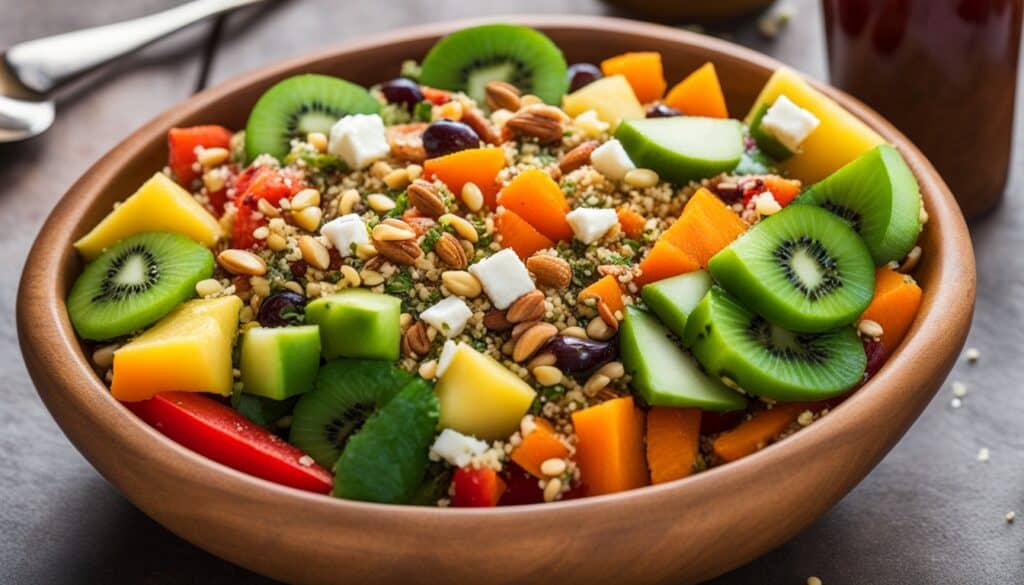
Fiber is key for a healthy digestive system and overall health. There are many ways to add more high-fiber breakfast options, high-fiber lunch and dinner ideas, and high-fiber snacks to your meals.
Breakfast
Begin your day with a fiber-packed breakfast. Pick whole-grain cereals, oatmeal, or add unprocessed wheat bran or uncooked oats to your cereal. Add fresh fruits like berries or bananas for more fiber.
Lunch and Dinner
Choose whole-grain breads, brown rice, or whole-wheat pasta for lunch and dinner. Include fiber-rich veggies like broccoli, carrots, and leafy greens. Legumes, such as beans and lentils, are also high in fiber. Add them to soups, stews, and salads for more fiber.
Snacks
For snacks, go for fresh fruits, raw veggies, whole-grain crackers, nuts, and seeds. These snacks are high in fiber and help you stay full and satisfied between meals.
By choosing wisely and adding fiber-rich foods to your meals, you can easily high-fiber breakfast options meet your daily fiber needs. This supports your overall health.
Fiber Supplements and Fortified Foods
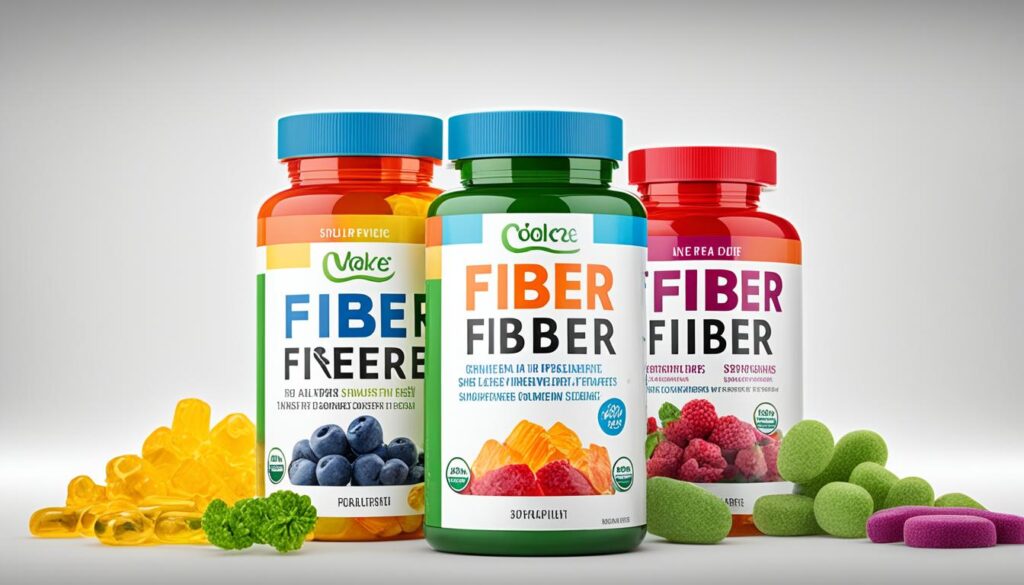
The best way to get more fiber is through whole, fiber-rich foods. But, some people might use fiber supplements or fortified products. Fiber supplements, like Metamucil, Citrucel, and FiberCon, add extra fiber. Yet, they don’t have the same nutrients as natural foods.
Fiber supplements can help with constipation, diarrhea, or irritable bowel syndrome. But, talk to a doctor before starting them. They can affect how some medicines work. Also, some people might feel stomach discomfort at first, so start with a little and go slow.
Another way to get more fiber is through fiber-fortified foods, like cereals, granola bars, yogurt, and ice cream. These foods can help with fiber intake. But, eating whole, fiber-rich foods should be your main focus.
“Fiber supplements can be a useful addition to a high-fiber diet, but they should not replace the consumption of whole, fiber-rich foods.”
Think about the benefits and drawbacks of fiber supplements before deciding. A balanced diet with whole, fiber-enriched products is best for meeting fiber needs.
| Fiber Supplement Types | Potential Benefits | Potential Drawbacks |
|---|---|---|
| Psyllium (Metamucil) | – Relieves constipation – Lowers cholesterol |
– May cause gas and bloating – Potential for medication interactions |
| Methylcellulose (Citrucel) | – Improves bowel regularity – May help with diarrhea |
– Can cause abdominal discomfort – May interfere with nutrient absorption |
| Calcium polycarbophil (FiberCon) | – Relieves constipation – Helps maintain healthy blood sugar levels |
– May cause gas and bloating – Potential for mineral deficiencies |
Gradually Increase Fiber Intake
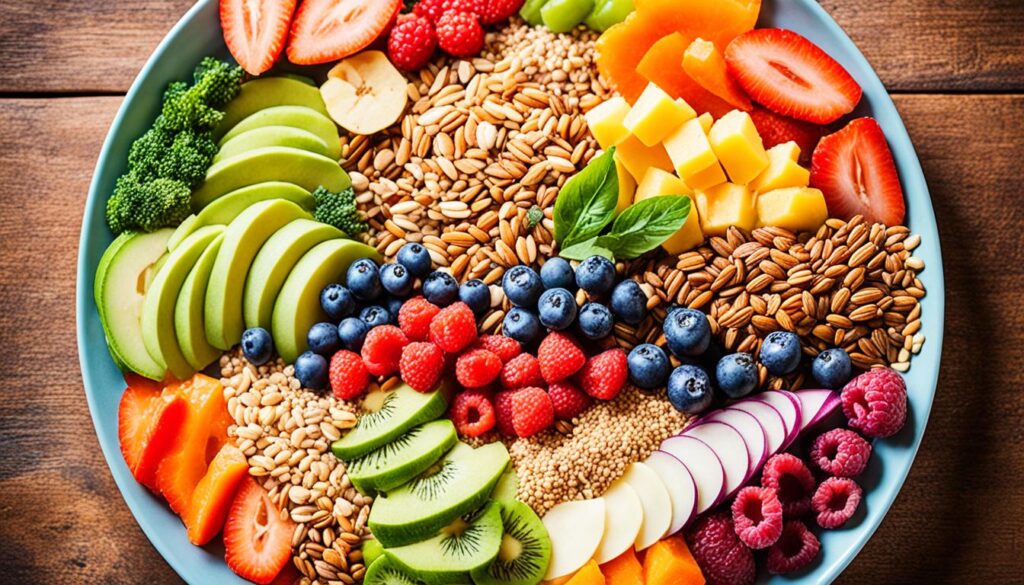
When you want to increase your fiber intake, do it slowly. This lets your digestive system adjust. Adding too much fiber too fast can cause intestinal gas, abdominal bloating, and cramping. To avoid these issues, gradually increase your fiber consumption over a few weeks. This lets your body get used to the change.
Also, make sure to drink plenty of water. Fiber absorbs water, making your stool soft and bulky. By gradually adding more fiber-rich foods to your diet and staying hydrated, you can easily transition to a high-fiber lifestyle. You’ll enjoy the health benefits without the unpleasant gastrointestinal discomfort.
Here are some tips to help you adjust to a higher-fiber diet gradually:
- Start by adding 5-10 grams of fiber per day, then increase by 2-3 grams each week.
- Focus on adding more whole grains, fruits, vegetables, legumes, and nuts to your meals.
- Drink plenty of water throughout the day to help the fiber move through your digestive system.
- Be patient and give your body time to adapt to the gradual increase in fiber intake.
By following these tips and gradually transitioning to a high-fiber lifestyle, you can enjoy the numerous health benefits of a fiber-rich diet. You won’t have to deal with any gastrointestinal discomfort.
“Increasing your fiber intake gradually is the key to avoiding unpleasant side effects and successfully incorporating more fiber into your diet.”
Conclusion
A high-fiber diet is key for good health and well-being. Fiber is found in many plant-based foods. It offers many benefits like regular bowel movements, better bowel health, lower cholesterol, controlled blood sugar, and helps with weight management.
Adding more whole grains, fruits, vegetables, legumes, and nuts and seeds to your meals can boost your fiber intake. This meets the daily fiber needs of 25-30 grams.
By making small changes, you can enjoy the health perks of a fiber-rich diet. Understanding the importance of dietary fiber and tips for increasing fiber intake helps you live a high-fiber lifestyle.
Small steps towards eating more fiber can greatly improve your health. By choosing fiber-rich foods daily, you start a path to a healthier life.
FAQs
Q: What is a high fiber diet?
A: A high fiber diet is one that includes a variety of foods that are naturally high in fiber, such as fruits, vegetables, whole grains, and legumes.
Q: Why is it important to consume foods high in fiber?
A: Fiber is an important part of a healthy diet as it can help prevent constipation, aid in weight loss, and support a healthy digestive system.
Q: What are some examples of foods that are high in fiber?
A: Foods such as whole grains, fruits, vegetables, nuts, seeds, and legumes are excellent sources of fiber that you can incorporate into your daily meals.
Q: How much fiber should I aim to consume each day?
A: The recommended daily intake of fiber is around 25-30 grams for adults. It’s important to gradually increase your fiber intake to avoid digestive discomfort.
Q: Are there any side effects of consuming too much fiber?
A: Consuming excessive amounts of fiber can lead to bloating, gas, and diarrhea. It’s important to drink plenty of water when increasing your fiber intake.
Q: Can a high-fiber diet help with weight loss?
A: Yes, incorporating high-fiber foods into your meals can help you feel full for longer, which may aid in weight loss by reducing overall calorie intake.
Q: What are some tips for adding more fiber-rich foods to my diet?
A: You can start by including more whole grains, fresh fruits, vegetables, and legumes in your meals. Gradually increase your fiber intake to allow your body to adjust.
Source Links
- https://www.ucsfhealth.org/education/increasing-fiber-intake
- https://www.mayoclinic.org/healthy-lifestyle/nutrition-and-healthy-eating/in-depth/fiber/art-20043983
- https://www.healthline.com/nutrition/16-ways-to-eat-more-fiber








Leave A Comment